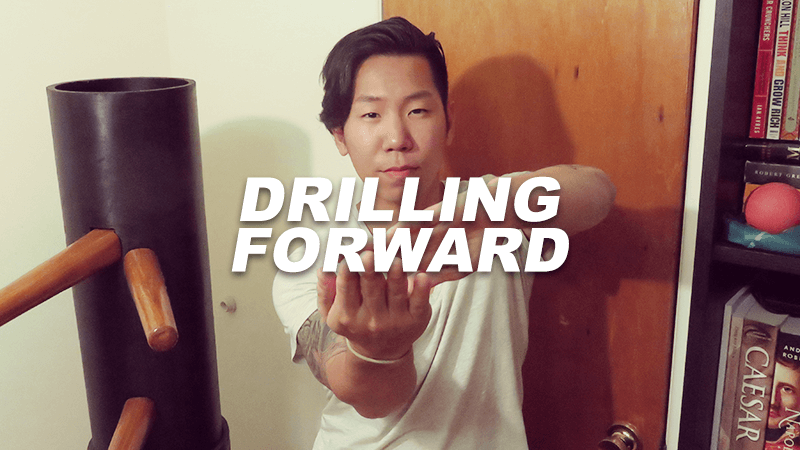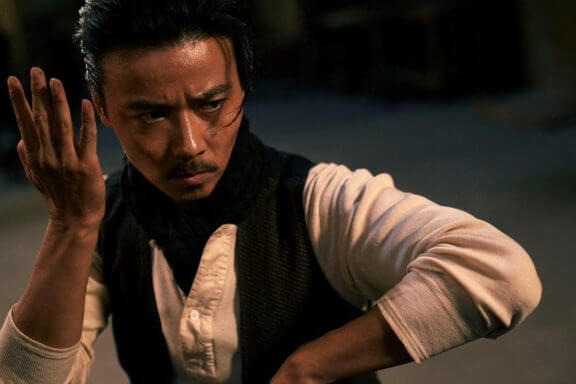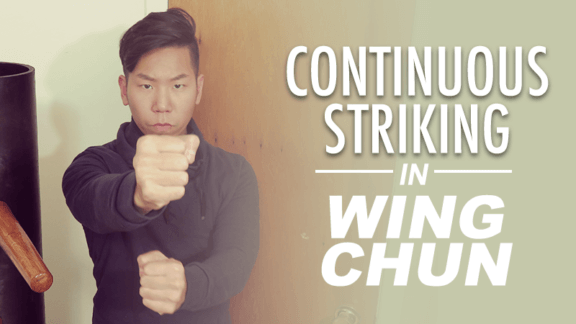The Importance of Footwork in Wing Chun
Drilling Forward and Rooting
Here’s a drill that helped me focus on rooting myself and driving my energy forward!

This drill requires a partner! So grab your training partner if you want to try it out.
Decide who will be defending and who will be attacking.
The person defending will need to create a box on the ground. That box is where they need to stay in. The goal of the defender is to hold their ground and stay in the box. If they move outside the box, they lose! Here are a few exceptions:
- You can step forward but only to strike
- You can only take, at most, one step back or else you lose
The goal of the person attacking is to move the defender out of their box. This can include grabbing, pushing, baiting, or any other method that can lure or move the defender out.
One tip for this game is to avoid pushing because it ends up turning into a battle of who’s stronger. The goal of the game is to work on both persons’ techniques!
This is a very fun drill so give it a try and let me know how it goes!
Wing Chun Moves – Taking a Step Forward
In boxing, a straight punch can cause a knockout especially if you’re Manny Pacquiao. The reason is because Manny is so fast with his attacks and the fact that when he throws a punch, two or three more follows. His style of punching resembles the chain punches in Wing Chun because the punches doesn’t stop.
Let’s go back to Wing Chun. Imagine getting chain punched and stepping backwards. What happens? You keep getting punched! By backing up from the oncoming attacks, it gives the attacker more room and space to continue their chain punching. But by simply taking a step forward into the chain punches can increase the chances of finding an opening in the attacker because they now have a limited amount of space to move in.
The movement of stepping forward is a very important concept in Wing Chun because by stepping forward into an opponent’s space, you close the distance. The problem with this concept is that many people, including me, naturally back up when being attacked to avoid being hit. Using the example of chain punching, this can be a problem, so by stepping into the opponent, it will change the momentum and rhythm of their attack. There’s still a possibility of receiving a few punches before successfully countering but that’s normal, everybody gets hit.
My friend Dave, who has a lot of experience competing and training in Muay Thai (Kickboxing), also mentions how moving forward works well in the ring since the opponent backs up creating space to be attacked. It’s funny because Dave says the reason he moves forward is because the gym he trains in is small so there’s no room to back up.
I found a Youtube clip of Manny Pacquiao. Watch closely, you’ll notice he usually steps in with his barrage of punches even when his opponent throws jabs to try to keep him out. He keeps pressure on them without backing off and then unloads his punches.
In theory, it seems very simple but psychologically it takes a lot of mental training. No one wants to get hit but acknowledging the fact that getting hit is part of learning can make it easier to accept. This doesn’t mean jumping into an opponent’s attack, be smart about it and start to understand when it’s the right time to step in.
Some attacks only do damage when the arm can fully extend, such as a punch or a chop to the throat, but by cutting the distance, they lose the power of a full strike because their distance is cut in half, so to create space…they actually need to step back to strike which gives you an opening to attack.
Intermediate Stepping
I haven’t always been active on my feet during Wing Chun class. For the first few years, I stayed mostly stationary and occasionally shifted or stepped back during drills or Chi Sao. Only in the past two years I started moving more on my feet by stepping in.
Let’s talk about an intermediate technique: stepping in.
One of the main weaknesses of my step is that I would put a lot of emphasis on my forward stepping leg. All my weight would go there which made me lunge forward. It’s been a very hard habit to correct…until this past weekend during class when I noticed my Sifu stepping differently than I did. I stepped with the balls of the foot (the front part of the foot) but my Sifu stepped with the heels of the foot (back part of the foot). This changed how I approached stepping because once I tried it, it felt completely different from what I was originally doing.
This was an eye opener for me. One change in placement changed my entire movement and technique. One little change!
Keeping the Distance & Push/Pull Technique
Here are some class notes about keeping the distance and the push/pull technique!
Keeping the distance is a fundamental of movement in Wing Chun. When an opponent steps into you, you keep the distance by taking the same distance stepping back. The idea is if the distance between you and you opponent remain the same, neither person will be able to strike the other. According to my Sifu, he says that Grandmaster Ip Chun is a master at keeping the distance and when he does close the distance, it’s to attack.
This leads to the next topic, pushing and pulling. If your opponent commits to their strike to attack and charges forward, you can take advantage of their momentum by controlling where they go with a pull. The same is applied when they try to pull you. Instead of resisting, use the energy they’re using for pulling and step into them knocking them with their own energy.
Foundation First, Strike Later
I’ve been trying to drill this over and over in my head.
Establish my foundation, or my footing, first before striking.
Here are 3 reasons why it’s important to me:
- It’s easy to get caught up using my arms first because it’s my instinct to clear what’s in front of me. I think that’s one of the disadvantages of such a close range martial arts because my brain is constantly screaming at me to step back and get away from all these close range strikes my opponent throws at me. So to counter my instincts, I would occasionally, sometimes, strike impulsively. And when I do, I lead with my arms and I end up putting my weight on the front of my leg which makes me lean my head in. This is bad because it makes me much more vulnerable to being hit in the head.
- To follow up on leading with my arms first, if my legs aren’t rooted, I can’t put my entire body behind my strikes. So then the power of my strike is limited to the strength of my arms. But if my legs are ready and in position, it lets me generate more power.
- Like striking, having a good foundation improves my defense as well. If i’m just using my arms to defend, chances are I’m relying on my muscles. So that Bong Sau I’m doing, is taxing my shoulder. That’s not a good thing. I want to make sure both my feet are planted so I can Shift with my Bong Sau.
Anyway, this is what I’m currently focusing on. This is my current mantra and it’s only 4 syllables: Feet First, Hands Second.
Close the Distance
What’s the difference between a strike that lands with a fully extended arm versus a strike that lands before the arm is full extended?
The immediate difference is in power. If my striking arm is already fully extended, I am at the limit of my range and power. The only way I can think of to correct this is by closing the distance which gives my striking arm more range to strike with more power, making my attack more effective.
The way I practice closing the distance is by stepping in. I go over the drill I do to practice. The basic steps are:
- Start from Wing Chun stance
- Step forward with one leg while keeping the weight on the back leg
- Return to Wing Chun stance
- Lead with alternate leg then repeat
Once you get used to the movement, you want to practice this with a strike. Now, my Sifu says that our striking hand should be the same side as our back leg when we do this stepping drill.
Defend & Advance
I commonly move forward to strike and backward to defend. Sometimes I don’t realize I’m stuck in this forward/backward mentality loop. In my mind I feel like I’m making progress but I’m just essentially taking one step forward but two steps back. To change this, I had to change my mentality.
I was introduced to the idea of retreating at an angle. The slightest shift in angle can change everything. If I were defending, I just disrupted my opponent’s momentum and created an opportunity. I can use this opportunity in many ways: I can strike, close the distance, or switch my role with my opponent to become the one on the offense.
A lot of opportunities can come from this little idea!
Hold Your Ground
In class we went over a drill that was really fun that works your fight or flight response. This was the first time I’ve done this drill in class so it took a while to get used. It was hard to not back up or step to the side but once I got used to it, it became very interesting.
When I was defending and holding my ground, I realized my opponent could only throw the same type of strikes and this made it easier and easier to block and deflect.
When I was on the offensive, I also realized how quickly my attacks were limited to just a few strikes. At such a close distance, without space to step in on, there was not enough momentum to generate any power in my strikes. So even at such a close range, my strikes were essentially useless. This was definitely a very interesting insight.
If you want to practice this drill, grab a partner! There are two roles, one defender and one attacker.
- Defender: Defend without stepping back but you can shift. Also, don’t try to push your attacker back, keep the distance close.
- Attacker: Attack and close the distance. Do not step back when there’s no more room to generate power for your strikes.
Switch roles after two minutes.
Don’t step into your opponent’s fist
A bad habit of mine is leading with my upper body (usually my head) as I close the distance and step forward. If my opponent throws a strike towards my face, I’m in trouble. Since I’m already in motion, there’s no way for me to stop once I’m committed.
So what’s the best way to deal with this bad habit? Let’s go back to our Wing Chun stance. In my Wing Chun stance I lean back slightly and this is also the proper structure I should maintain while I step into my opponent’s space.
To train this, I have to drill myself to step in and out towards a target while maintaining my structure without leaning in. Once I get that down, I include the arms.
It’s definitely a work in progress for me but I think it’s definitely worth working on.
P.S. Here’s the fight I was referring to in this week’s video:
Side Stepping in Wing Chun
Yesterday in class I focused on the applications of section 6 of the Wing Chun Dummy Form. I focused on stepping to the side. In my original step, I place all my weight on the front leg and lead with my head first. That’s a bad habit and my Sifu helped me realize that. He demonstrated how he does it by keeping the weight on the back leg and NOT leading with the head leaning in, haha. Since it’s a bad habit of mine, it will take time for me to adjust and correct it. I hope you can learn from my mistake and correct your bad habits early.
Spring into Action!
Spring action amplifies the power behind each technique.
The idea behind the spring action is fully utilizing the whole body to use a technique, whether it’s for striking or defending. This means using the whole body from the ground up.
I’m still experimenting and finding the best way for me to utilize it. At the moment, the best way for me to do it is based on how my friend Marc explained it. He said think of it as retreating inwards then bouncing back out. In and out, essentially. This made it much easier to understand and allowed me to use the spring action more often. Of course, it’s still a work in progress and I’m going to continue testing it out.


